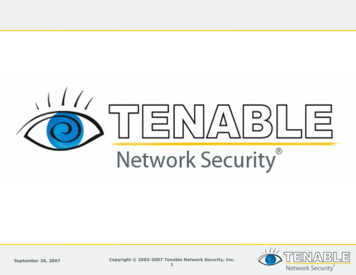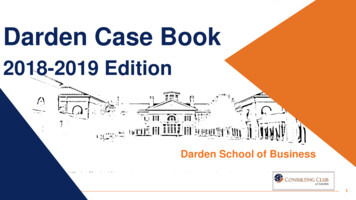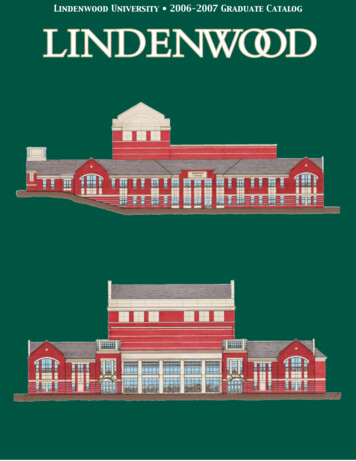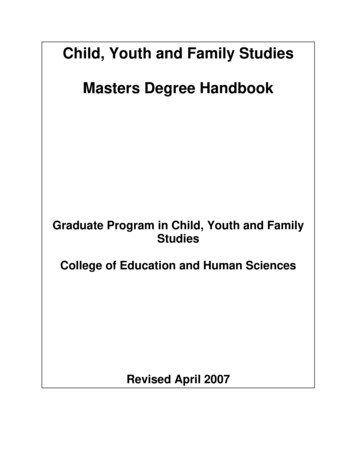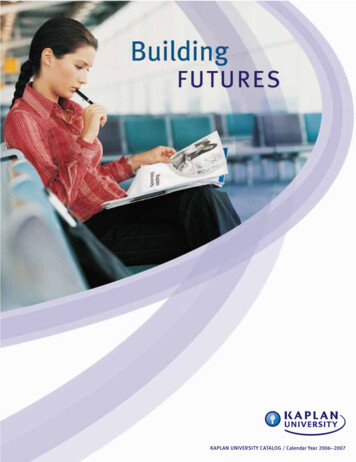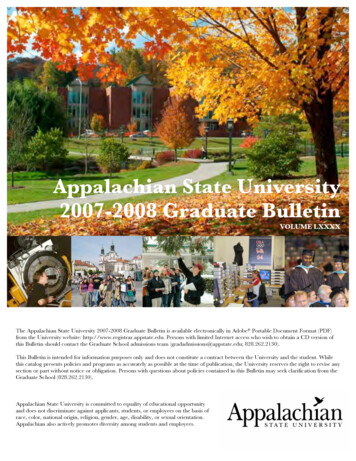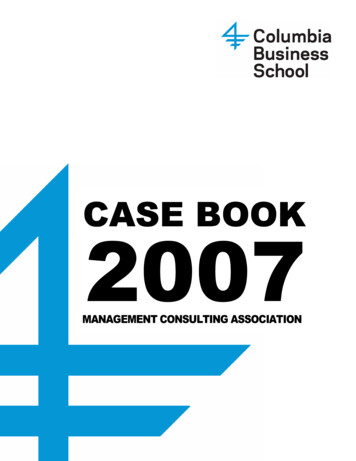
Transcription
CASE BOOK2007MANAGEMENT CONSULTING ASSOCIATION
Table of ContentsCASE 1: University Bank . . .3CASE 2: Mine in Chile . . .7CASE 3: UPS in Italy . . .12CASE 4: Refrigerators in India .16CASE 5: Mexican Dishes . 20CASE 6: Centralized Distribution . 23CASE 7: Health Care in Canada . . 25CASE 8: International Airline . . 29CASE 9: Seattle Newspaper . . 33CASE 10: Jumbo Jet 38CASE 11: Telecom . 41CASE 12: Mining in Brazil . 44Cases written by Eduardo Fichmann, Jonathan Gerszberg, Michael Levenberg and Zhila Shariat.Edited by Kathryn Van Pelt and Dan Fishel.2007 All rights reserved to the Management Consulting Association, Columbia Business School.Do not reproduce or distribute without permission of the MCA.Management Consulting Association Case Book 2007-2-
Case 1: University BankBACKGROUNDFirm: Boston Consulting GroupRound: 2007 Summer, FirstContent: Qualitative and quantitativeCASE QUESTIONIn Mexico banks prefer not to lend money to hospitals and schools because if one of theseinstitutions defaults the Bank worries that it will be seen as the one responsible forliquidating their assets. We have a client who currently owns several universities. He isevaluating whether an opportunity exists to start a bank that would lend money to hisvarious universities. There are three questions that he wants us to solve: Is there an opportunity to lend money to universities? If an opportunity exists, how big is it? How should he structure the bank?INTERVIEWER BRIEFINGRecommended approach: The purpose of this case is to test the interviewee’s ability todetermine whether it makes sense for the client to open a bank that serves universities. Inparticular, the interviewee should recognize that he/she needs to gather the necessaryinformation to determine the market opportunity for such a bank. The interviewee shouldask questions to gather the necessary information to determine the market size.Key facts: Population in Mexico is:o 0-15 years old: 7 milliono 15-30 years old: 6 milliono 30-45 years old: 5 million Total number of universities in Mexico: 200 Population growth: close to zero (use zero for the sake of simplicity)EXAMPLE DIALOGUEInterviewer: So, given the facts of the case, how would you consider going aboutanalyzing this question for the client?Interviewee: I’d like to understand a few things to evaluate this decision. First, I’d like tounderstand the size of the market to see whether there is an opportunity or not. Next IManagement Consulting Association Case Book 2007-3-
would like to analyze who are the competitors, if any. In particular, I am interested in thecompetitors because they may decide to offer similar loans to institutions, likeuniversities. Finally, I would like to know what the university can leverage from its ownoperations to develop this idea, etc.Interviewer: That seems like a good starting point. Let’s start by analyzing the market.How would you do that?Interviewee: Ok, I will start by analyzing how many people go to university per year. Ifthe population grows at about 1% per year, this means that next year there could be morepeople attending universities than space available. I would use a guesstimate of thepercent of population enrolled in universities to calculate the number of studentscurrently enrolled across Mexico. For simplicity sake I will assume that all potentialstudents attend universities in Mexico, excluding the percent that attends school abroad.Age rangePopulation0-15 years old15-30 years old30-45 years old7 million6 million5 million% Enrolled inUniversity(guesstimate)0%25%2%Enrolled InUniversity0.0 million1.5 million0.1 million1.6 millionThere are roughly 6 million Mexicans between the ages of 15 and 30, and I wouldassume that they are evenly distributed. That is, there are 400,000 people in each year ofage (e.g. 400,000 people who are 15 years old, 400,000 people who are 16 years old, andso on until the age of 30). If I assume that 25% of the people between the ages of 15 and30 go to university, that means we have 1.5 million students between the ages of 15 and30.Interviewer: Those assumptions seem to be very good ones. What else would you need toconsider?Interviewee: Ok, I think that I will need to figure out how many schools there are inMexico and how many students are enrolled in each school.Interviewer: Sure, our client has told us that there are 200 universities in Mexico and wecan assume there they are all at full capacity.Interviewee: Ok, so 1.6M divided by 200 means that there are 8,000 students at eachschool. I might think that this seems like a high number. In the United States we havepart-time students and full-time students. If this is similar in Mexico, the universitieswould likely be able to accommodate more students without any investment.Management Consulting Association Case Book 2007-4-
Interviewer: No, they can’t do that as the law prohibits it.Interviewee: Okay, so if the population grows at 1% per year and there are no newpeople going to university for other reasons (e.g. better economy) this means that in anygiven year we will have 1.6M multiplied by 1% new students. We would have 16,000incremental students. Given that we know the schools are at full capacity, we wouldneed two new schools.Interviewer: Okay, so now let's focus on how would you segment the schools in order tothink about the credit scoring they may have?Interviewee: I would segment them based on: New school or just new branch to an existing school. I believe that it is less risky tolend to a company that already has a business in place. Flow of people to school: it's much more secure to lend to a school that has plenty ofstudents in each year than to one that has the same number but distributed in adifferent way (e.g. most of the people finishing their careers and almost nobody in thefirst or second year). Geography: We are speaking in averages. There may be areas with no populationgrowth. There may be an uneven dispersion.Interviewer: How would you calculate how much money a typical school would need?Interviewee: There are two different streams of costs we have to consider. On the oneside the cost of building a new school – including buying the land, the construction, etc. –and the funds needed until the company reaches a state in which it has a positive freecash flow.Interviewer: Great. Tell me the number, or at least how to get it.Interviewee: The better is to rely on our client experience. He has 15 schools so thereare some experiences we can leverage there?Interviewer: Let’s move on. How would you fund this project?Interviewee: I will think about a couple different ideas such as: Unilateral organizations (e.g. World Bank, etc.) The Government as it may need to help some private schools that focus on careersthat are not available through public university. Banks: They may not be willing to do this on their own but may want to partner withsomeone that knows about this industry.Interviewer: Ok, fair enough. Our client is asking you to summarize the situation. Whatwould be your recommendation?Management Consulting Association Case Book 2007-5-
Interviewee: Can I take a moment to recap all the findings?Interviewer: Sure.Interviewee: I will tell the client that it seems to be a pretty interesting opportunity toprovide capital to build new schools which would be at least two per year given thegrowth in the population.Management Consulting Association Case Book 2007-6-
Case 2: Mine in ChileBACKGROUNDFirm: Boston Consulting GroupRound: 2007 Summer, FirstContent: OperationsCASE QUESTIONOur client is a company which is going to exploit a mine that is expected to be full of avery unique ore, and has asked us in which order his company should extract the ore fromthe field. The ore will then be sent to a factory that his company already owns.INTERVIEWER BRIEFINGRecommended approach: The interviewer is testing whether the candidate can identifya useful algorithm to determine the best way to extract ore from this field. The candidateshould not initially waste any time developing one idea too fully; instead he/she shouldcome up with a few reasonable suggestions and test them for validity with theinterviewer. The candidate should, like in most cases, be aware that he/she is missingcritical information and should identify what he/she needs to solve the case and then askthe interviewer for this data.Key facts: The field is divided in cells of equal size. Once you blow one cell there is no way thetruck can pass through it to go to the factory. This is a plan of the plant:FactoryTrucks enter here with rockscontaining 1% of ore.The output is 100% oreManagement Consulting Association Case Book 2007-7-
Each cell has different ore content and therefore each cell has a different cost ofextraction.No growth in population (for sake of simplicity).EXAMPLE DIALOGUEInterviewer: So, tell me how we might approach this problem for our client?Interviewee: First, I would like make sure that I fully understand our client’s needs. Letme repeat the key issues Our client wants us to provide him with a recommendationon what approach his team should take to extract the ore in order to maximize profits.Interviewer: Yes, that pretty much sums it up. So, what’s next?Interviewee: I can imagine a number of different ways of prioritizing which cells to takeout first, such as: Profit: Price – Cost.Demand: Outlook of the price of the different types of ore. If the price is low(perhaps because demand today is lower), but we believe that this same ore will besold for much more in the future (perhaps due to an increase in demand), it couldmake sense to begin extracting lower concentration cells.I am imagining that this could be similar to the oil industry. Think for example aboutthe price of oil. The oil is in the field anyway so it’s better to exploit the places whichthe least of it when the price in the market is at a low level. Unless, of course, we canstore the ore for long periods of time without a large opportunity cost by tying upcapital and space.Capacity of the plant: Maybe there is a minimum level we need to provide to the plantas input. Maybe there is a maximum this could determine how much we want toextract in any given time period, especially, if there are penalties for operating outsideof this min-max range.Operational issues: For example, if I dig a hole in the ground and the truck cannotpass through that cell, it may be wise to start at the cells that are further from thefactory so that I do not block off routes.Interviewer: Ok, let’s assume that the points that you have raised are all reasonable.This is a complex business and I was pleased to hear you touch on many of the importantpoints. But, first, let’s focus on profits. How would you define profit?Interviewee: Ok, in this case profits would be (price of a ton of ore) * (expected contentof ore in cell) – (the cost of extraction for that cell). I will then rank each of the cellsbased on its overall profit contribution and determine my extraction path from there. Ofcourse, we need to consider that if we extract from one highly profitable cell, but it cutsManagement Consulting Association Case Book 2007-8-
off access to a lesser, but still profitable, cell, this is a cost of doing business under thisassumption and should reduce my overall expected profits.Interviewer: Let’s assume that we map the field and this is what we get:Cell 1x 1.0C 3Cell 2x 1.3C 10FactoryCell 3x 1.1C 5x tons of ore in that cellC cost of extracting in that cellInterviewee: Do we have any information on today's price of ore?Interviewer: Yes, our client expects to get 10 dollars per ton of ore.Interviewee: So, for Cell 1 the profit will be: 1*10 – 3 7. For Cell 2 would be: 1.3*10– 10 3. For Cell 3 would be: 1.1*10 – 5 6. So I will start for Cell 1, then Cell 3 andfinally exploit Cell 2.Interviewer: Ok. What if price changes? Does it change your decision?Interviewee: Yes.Interviewer: Why?Interviewee: Let’s say price is now 30 per ton. For Cell 1 the profit will be: 1*30 – 3 27. For Cell 2: 1.3*39 – 10 29. For Cell 3: 1.1*30 – 5 28. So I would recommendextracting Cell 2, then Cell 3 and finally Cell 1. This is based on the fact that the costsappear to be fixed and do not change despite the overall price fluctuations that we arediscussing.Management Consulting Association Case Book 2007-9-
Interviewer: Let’s move on. Our client has told us that per ton P&L statement is asfollows wait, perhaps you could tell me how you would construct it?Interviewee: I would try to find out the average price, the average cost of goods sold andthen assign some part of the SG&A costs.Interviewer: Ok. Here are the figures that our client provided. What is the company’sbreak-even point?ItemRevenuesCOGSSG&AProfit per ton1.00.80.6-0.4Interviewee: Ok. The company has 0.2 gross margin per ton of ore, before we factor inSG&A costs. So, if I divide SG&A by the gross margin I will find how much they haveto produce. In this case, 0.6 / 0.2 3, which means they have to produce 3 times moreto cover fixed costs.Interviewer: How the same P&L would look like?Interviewee: Basically, we have to divide the SG&A by 3. We are in essence spreadingthe fixed SG&A costs across more units. However, we would need to make sure thatSG&A does not increase with volume of ore extracted.ItemRevenuesCOGSSG&AProfit per ton1.00.80.20.0Interviewer: Okay, can you summarize what we have identified?Interviewee: Sure. Our client was looking for a framework to identify the order in whichhe should extract cells of ore from a field. We chose to focus on profitability as the maindriver. As mentioned, but not discussed in depth, profitability
Management Consulting Association Case Book 2007 - 4 - would like to analyze who are the competitors, if any. In particular, I am interested in the competitors because they may decide to offer similar loans to institutions, like universities. Finally, I would like to know what the university can leverage from its own
